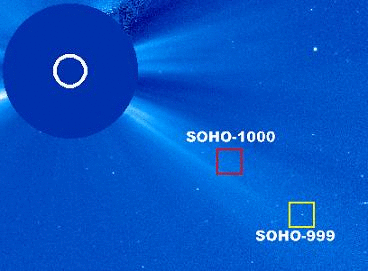As comets orbit around the Sun and once in a while crash into it, the SOHO takes their pictures. Scores of volunteers pore through the videos from the craft, and often are the first to spot new comets. Toni Scarmato, a high school teacher from Italy, discovered SOHO's 999th and 1000th comet recently, when two comets appeared in the same SOHO image:):).

The twin comets (Courtesy: SOHO)
SOHO has also been used to discover three other well-populated comet groups: the Meyer, with at least 55 members; Marsden, with at least 21 members; and Kracht, with 24 members. These groups are named after the astronomers who suggested the comets are related, because they have similar orbits.
Almost all SOHO's comets are discovered using images from its Large Angle and Spectrometric Coronagraph (LASCO) instrument. LASCO is used to observe the faint, multimillion-degree outer atmosphere of the sun, called the corona. A disk in the instrument is used to make an artificial eclipse, blocking direct light from the sun so the much fainter corona can be seen. Sun grazing comets are discovered when they enter LASCO's field of view as they pass close by the star.
A large animation of the comets can be found here.
Is that SOHO's 1000th comet or 1000th comet known to man?
ReplyDeleteThe post says that. Toni Scarmato, a high school teacher from Italy, discovered SOHO's 999th and 1000th comet.
ReplyDeleteHummm.. looks like a planet to me! Perhaps Mercury?
ReplyDeleteI'm guessing I'm right in assuming that the comets don't get anywhere near the Sun?
ReplyDeleteGiven the sun is very, very, very, very, very, very .. very hot, is it fair to say that the comets simply vapourize?
Well, 'getting near' is a relative term. There are different kinds of comets. The carboneceous ones vaporize. The metallic ones might stay up a little longer. Some comets dive into the Sun, others might take a very close orbit and shoot back out!
ReplyDeleteIt's a little bit misleading to write here that SOHO is "fixed" in orbit between the earth and the sun and that this cancels out earth's gravity.
ReplyDeleteKepler's third law of motion defines orbital periodicity ... and requires that an object closer to the sun move faster.
The period for a body to orbit the Sun increases rapidly with the radius of its orbit. By way of example, Mercury takes only 88 days to orbit the Sun, but Pluto requires 248 years to do so.
So it seems likely that SOHO is in an orbit closer to the sun, but it is not "fixed" between the earth and the sun. Sometimes it must be on the opposite side of the sun and earth's gravity is irrelevant.
/e
Thanks for your visit:). I was being a little bit loose with my words when I said that 'SOHO is fixed between Earth and Sun'. Actually, SOHO is at a Lagrangian point. There are five such points around two bodies in space. Any third body placed there, is always stationary relative to the first two.
ReplyDeleteThe Keplerian law is for a idealized planet/other object (perfectly spherical, uniform density) orbiting another idealized point star/other object. When three bodies are involved, it is a classic three-body problem, and you have those five fixed-points in space.
you're a wizard! lol. i think i got what i deserved, a public display of my scientific illiteracy. it's deserved for (1) blogging past my bedtime, (2) not thinking it through, and (3) not even bothering to look up SOHO before posting ... (lol)
ReplyDeletemy apologies. great site. discovered yesterday. don't think i'll be able to resist visiting daily.
thanks for publishing this incredible array of neat stuff.
/e
:))... no problem! You gave me a chance to explain something that I should have explained in the post, but was too lazy to do :-$.
ReplyDeletecomets can be metallic too? i thought they were just ice
ReplyDeletebut how is it possible for some comets to shoot back out? what would that depend on? just curious.